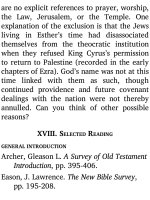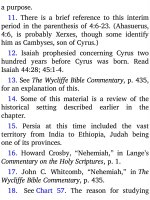Jensens survey of the old testament adam 463
Bạn đang xem bản rút gọn của tài liệu. Xem và tải ngay bản đầy đủ của tài liệu tại đây (116.76 KB, 4 trang )
E. AUTHENTICITY
First Corinthians is one of the bestattested epistles as to authorship and unity
of content.
IV. SURVEY OF 1 CORINTHIANS
A. FIRST READINGS
By now you have established some
patterns for surveying a Bible book, so all
the various steps will not be repeated here
nor in the chapters that follow. Be sure to
include:
1. first quick scanning, followed by a
slower scanning
2. observing of key words, phrases,
atmosphere
3. assigning segment titles (For 1
Corinthians each chapter is a new
segment, with these two changes: 11:2
replaces 11:1 as a beginning, and
chapter 1 may be divided into two
segments: 1:1-9 and 1:10-31.)
4. comparing the beginning and end of
the book
5. looking for turning points,
progressions, and climax, if any.
B. CORRELATIONS
You can move out in various directions in
your study from this point on. Some “search
missions” are suggested below. Your
ultimate aim, of course, should be to
correlate all your observations into one
overall picture of 1 Corinthians. (Note: Be
sure to read every Bible reference cited
below.)
1. Look for groupings of chapters
according to a common subject. A clue to
this is Paul’s use of phrases such as, “I have
been informed” (1:11; 5:1) and “Now
concerning” (7:1, 25; 8:1; 12:1; 16:1 [cf.
11:2]). Actually, as to general structure, 1
Corinthians is one of the simplest of Paul’s
epistles. Justify the twofold outline shown
on Chart 70: acknowledging reports; answering
inquiries. What kinds of problems are
discussed in chapters 1-6? What kinds of
questions are discussed in chapters 7-15?
2. How do 1:1-9 and 16:1-24 serve as
introduction and conclusion, respectively?
3. First Corinthians is one of the most
practical of all Paul’s epistles. Make a note
of all the problems explicitly mentioned by
Paul in the epistle. Group those according to
common subject, and compare your
conclusions with the outlines of Chart 70.
4. After recognizing a problem in the
Corinthian church, Paul o ers solutions,
including examples of his own personal
experiences. As you survey the chapters of
this letter, keep aware of these three
subjects: problems, solutions, examples.
5. Go through the epistle and mark in
your Bible every block of positive doctrine,
contrasted with the discussions of the
various evils of the Corinthian church. (The
length of each block will vary from a
paragraph to more than a chapter.) Note
also where Paul gives personal testimony.
6. What chapters would you consider key
chapters for the particular subjects they
present?
7. What primary doctrines of the gospel
appear from time to time throughout the
epistle? Did you notice, for example,









